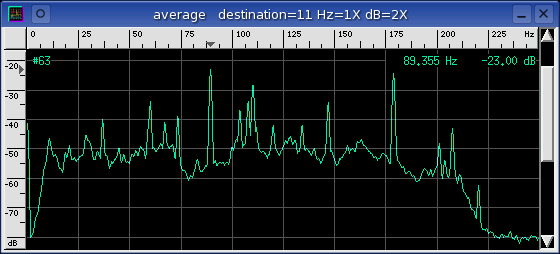We've got signal, but what the heck is it?
That's your mission. Analyze this bébé.

 download the audio file 2.wav.gz
download the audio file 2.wav.gz
hints :
-
Setup baudline to be a Netscape helper application as described
in the FAQ.
-
Ignore the 60 Hz AC power leakage and its harmonics (120 Hz,
180 Hz).
-
Turn on the 60 Hz notch filter in the play deck.
-
Try playing the mystery signal at different speeds, slow
it down or drop it an octave.
-
Loop on the transitional points, play it again and again
until you start to hear things.
-
Measure the harmonic relationships with baudline's
harmonic helper bars.
Use this handy tool to determine the fundamentals.
-
Look at the major frequency rise at the start, and the fall
near the end. How are they different? What is going on?
-
Look for clues in the four blips during the steady state
part. Model that behavior.
What is it?
It is a wood chipper also known as a tree mulcher. It takes
in tree branches, grinds em up, and spits em out. The device is usually
towed by a truck and it is powered by its own gas engine. Here is the
break down of the different sections of the sound file.
1) power up
Background silence transitions to the sound of a gas
engine starting up. The exhaust note stepping from 51 Hz to 52 Hz to 53
Hz indicates that the idle speed is adjusted two times. After idling
for about 10 seconds a clutch/gear mechanism is engaged, the engine bogs
down, and the massive tree grinding/chopping teeth start to spin. For 10
seconds there is an inverse exponential acceleration (34 Hz to 55 Hz).
Then the throttle is opened up and 12 seconds of linear acceleration is
experienced.
2) steady state
Operating speed is reached and sustained for 127 seconds.
The four dips in the constant speed represent tree branches tossed in that
briefly slow down the flywheel.
3) exponential decay
The engine is turned off and the spinning teeth under
go 95 seconds of exponential decay which is caused by air resistance and
bearing friction. Then for 3 seconds a brake is applied causing linear
de-acceleration which stops and silences the wood chipper. Note that
the 110 Hz to 90 Hz fuzzy trace at the end of file is just Doppler
shift of the 3rd harmonic of a plane flying overhead.
harmonic structure analysis
The plot below was created by selecting 30 seconds of
steady state signal and pasting that into the average
window. Next, extensive use of the
harmonic helper bars
were used to determine the complicated harmonic structure of this signal.
The two main causes of the harmonic structure are a fundamental at 18 Hz with
9 harmonics and a phantom fundamental at 22 Hz with 7 harmonics. These
two fundamentals are likely the engine exhaust note and the bearing /
vibrational noise of the main feed teeth. The 18 : 22 ratio is the
function of a gear/belt mechanism that couples the engine and the spinning
mass. Fundamentals at 103 Hz and 107 Hz, each with one harmonic, also
contribute. It is believed that these fundamentals represent the cutting /
grinding teeth spinning at high > 6000 RPM speeds which are geared off of the
main spinning feeding mass. The slower spinning teeth pull the tree
branches inward while the faster spinning teeth grind them up. Note that
this analysis is highly speculative and is based solely on the emitted sound
and a crude understanding of how the device works.

|
![]()